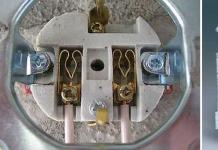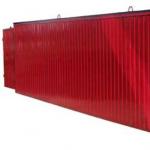Nutrition. First was cultivated in Southeast Asia, therefore prefers subtropical and tropical climates. In other climatic conditions, it is also grown, but used, and planting is done by seedlings.
Caring for eggplant requires special labor and attention, they are considered finicky plants, and it is not so easy for a novice gardener to cope with their cultivation. Many pests are not averse to feasting on the plant and ruining the crop. Important to be able to recognize and take measures to combat it in time.
Fighting spider mites
A common pest of nightshade is the spider mite. It cannot be seen with the naked eye, and the consequences of his presence are immediately visible - very voracious. Braiding the lower surface of the leaf with a small cobweb (looks like a “marble pattern”), the tick pierces it and feeds on the life-giving juice. The bush of the plant looks like it is constantly being injected (many holes appear on the leaves and trunk).
If you do not pay attention to this in time, then the trunk becomes stained, and the leaves are twisted into a tube. The reproductive function of the spider mite is very high, every 2-3 weeks a new generation appears. With an untimely response to this pest, you can lose the entire crop.
The use of chemicals includes acaricides. Following the instructions, a working solution is prepared for the preparations, which the plants are sprayed with. Greenhouses are fumigated by burning chemicals. Soil is cultivated around the plants.
These methods can be applied not only separately, but also by combining them.
Did you know? For those who are trying to quit smoking, it is advisable to include eggplant in your daily diet. It contains vitamin PP and reduces the need for nicotine.
Biological methods are directed against the spider mite and are safe for other creatures. They are divided into 2 types: Phytophages (predatory mites) that eat vegetarian mites and do not spoil the plant. In a short period of time, they are able to destroy large colonies of insects. They can be purchased at garden centers or specialty stores. Biological preparations against ticks, which are used in the form of solutions. They spray plants. 
Agrotechnical methods create an unfavorable environment for the existence of a tick: increase air humidity and increase foliar; plant plants that repel ticks; destroy; soil is being processed.
There are many folk remedies to fight and repel spider mites, but not all of them are effective. They include various infusions and decoctions that eggplant is sprayed with. As soon as you notice that pests in the form of spider mites have appeared on your eggplants, immediately start fighting them. To reduce insect numbers, remove and burn all weeds.
Damaged shoots and leaves should also be torn off and burned. Decide on a method of struggle and proceed to the destruction of the pest. After a few days, inspect the seedlings and make sure that the remedy you have chosen has helped. If a cobweb or new points appear again, then the chosen one is ineffective, and it should be replaced with other types of struggle. To be sure to get rid of the insect population, carry out the treatment repeatedly. And after the complete destruction of the pest, monitor the appearance of the seedlings and carry out to prevent new invasions. Prevention includes agrotechnical methods of insect control.
Aphid control measures
Aphids, like spider mites, suck the juice of plants. Although outwardly it looks harmless, it can cause huge damage to the crop. Her vital activity takes place on the leaves, stem and flowers of agricultural crops. Aphids do not feed on fruits, but are one of the most dangerous pests on eggplant seedlings.. The tissues of a plant affected by aphids become deformed and dry out. The deformation is due to the toxins that the insect releases when sucking life-giving juice. This pest covers the leaves with honeydew (sugar secretions), which is a favorable environment for soot fungus. Aphids also carry all possible bacteria. 
Plants affected by aphids slow down their growth, complete drying of young growths may occur. She is able to destroy an entire planting of seedlings. It is necessary to completely destroy this pest, because, having absorbed one planting of plants, aphids can hide and appear during the next planting seasons.
Important! Eggplant fruits, which were formed during the defeat of aphids, grow small in size and are unsuitable for consumption. They taste very bitter.

The fight against aphids must be comprehensive, otherwise the destruction may be ineffective. Immediately begin to apply chemical treatment with insecticides that decompose quickly. Such substances do not linger and do not accumulate in the plant. These drugs include: "", "", "Decis Profi", "". When using these drugs, strictly follow the instructions, each of them has its own scheme of application. Also take care of personal protection, the skin and mucous membrane are sensitive to pesticides. Use gloves, goggles or a mask. Work with poisons in dry weather.
Important! Do not treat eggplant with chemicals during flowering and fruiting.

Folk remedies are used if the defeat of aphids occurred during the period of flowering or fruiting. Several ways to fight:
- In a ten-liter bucket, mix the tops of potatoes, tomatoes, celandine, garlic and zucchini in a 1: 1 ratio, 1 glass of liquid soap and 400 g. Mix all this and leave in a dark place for three days. Stir occasionally. Strain the mixture and use once a week.
- In a 10-liter bucket, mix 50 g of chili pepper and 50 g of tobacco ash in warm water. Infuse for 2-3 days, and then add 3 tablespoons of soap and 200 g of wood ash. After straining, use 1 time in 2 weeks.
- Boil wormwood and tansy (1 kg each) in 2 liters of water. Dilute the strained broth to 10 liters and add 5 tablespoons of soap.
- Soak a kilogram of dried yarrow in 2 liters of boiling water, strain, dilute in 10 liters of water and add 5 tablespoons of soap.

Plants that it does not tolerate and insects that devour it will help to combat and prevent aphids. You can plant with eggplant,. The aromas of these plants repel insects. Insects that feed on aphids are ladybugs and bedbugs. But it is worth remembering that some of them can destroy other crops you grow.
scoops
The primary harm is caused during the planting of eggplant seedlings. The larvae wintering in the ground climb to the surface with warming. They are able to gnaw through the trunk of a young plant, and also feed on fruits. Appear both on the open ground and in the greenhouse. For two whole months they feast on agricultural crops, and then pupate.
In one season they are able to lay more than 2000 eggs. The most dangerous are scoops that have survived the winter. The larvae that have appeared are exterminated with chemical solutions "Inta-vir", "Karbofos", "Kinmiks". Prevention consists in loosening the soil after watering and removing weeds. 
How to deal with whiteflies
During the season, the whitefly gives more than 15 generations. Its appearance is typical for closed ground, where there is high humidity combined with high temperature. Favorite places are greenhouses and greenhouses. Insects suck eggplant juice. They are located on the back of the leaf, and on the surface of the lower sheet there is a whitish coating (litter of whiteflies), on which the fungus develops. It is believed that sooty fungus does more damage to seedlings. 
The cruciferous flea is a small bug only up to 3 mm in size. The insect hibernates in the soil and appears when the air temperature rises to 15 degrees. An insect can be of various colors depending on the species.
The pest is dangerous for all cruciferous plants. Radish, radish, horseradish are a favorite delicacy for the insect. The pest does not disdain eggplant foliage. But especially often a flea appears on cabbage seedlings. One has only to plant seedlings, as the edges of the leaves become covered with small holes, turn yellow and dry.
Article outline
Agricultural technology against cruciferous flea
The flight of the insect coincides with the time of planting cabbage seedlings in open ground. Tender young leaves are too attractive for the pest. If you do not protect the seedlings, then the flea will destroy them in a few days.
Pest control begins long before crops are planted. In autumn, after harvesting, it is recommended to remove and burn plant debris. It is better to dig up the top layer of soil so that the first frosts destroy the insect that has gone into hibernation.
 Throughout the season, it is necessary to remove the weeds that the flea loves. The colza, wild radish, rapeseed, horseradish are a real hotbed in which the insect develops.
Throughout the season, it is necessary to remove the weeds that the flea loves. The colza, wild radish, rapeseed, horseradish are a real hotbed in which the insect develops.
If this pest appears on the site every year, then you can avoid the defeat of young plants by changing the timing of planting. Cold-resistant crops should be planted early. The pest is not dangerous to developed plants. And leave heat-loving eggplants at the end of June, when they are no longer afraid of a flea.
Crop rotation helps to avoid many problems when growing annual vegetables. Proper planning of the site provides for the return of the culture to the place no earlier than in 3-4 years.
It will help to cope with the pest and sowing some flower crops around the cruciferous area or between plants. The flea does not tolerate the smell of wormwood, marigolds, nasturtium and calendula.
Folk ways to deal with a flea
The cruciferous flea does not tolerate dampness. If a suitable wet area for planting cabbage or eggplant was not found, then abundant watering of young seedlings should be provided.
Pollination
Dry pollination of wet leaves makes plants less attractive to the pest. You can sprinkle the seedlings in the morning, when the dew has not yet dried, or after watering from a watering can over the leaves. To protect against a flea, it costs or.
Make a bag out of gauze in two additions. Place the composition for pollination in it. When processing plants, it is important to cover the casting with a layer of dust on all sides. The disadvantage of this method lies in the easy washing off of dust during precipitation.
spraying
 Spraying plants with fragrant compounds will help get rid of fleas. A few cloves of garlic, infused in a liter of water for 2-3 hours, or a handful of tomato tops repel the insect. Spraying is carried out in the evening every other day for a week or two.
Spraying plants with fragrant compounds will help get rid of fleas. A few cloves of garlic, infused in a liter of water for 2-3 hours, or a handful of tomato tops repel the insect. Spraying is carried out in the evening every other day for a week or two.
Fir oil
The smell of fir oil, which can be bought at the pharmacy, is used against the cruciferous flea. But they need to be handled carefully so that the solution does not get on the leaves of the plant. Seedlings cover and shed with a row-spacing solution. A bucket of water requires 10 g of oil.
Vinegar
 Table vinegar will help scare away the pest from young eggplant and cabbage seedlings. The solution is prepared from a glass of vinegar to a bucket of water. If vinegar essence is used, then the proportions change. A bucket of water will require only a couple of spoons. Plants are sprayed with a solution every 2 days.
Table vinegar will help scare away the pest from young eggplant and cabbage seedlings. The solution is prepared from a glass of vinegar to a bucket of water. If vinegar essence is used, then the proportions change. A bucket of water will require only a couple of spoons. Plants are sprayed with a solution every 2 days.
Herbal decoction
Decoctions of weeds, which have a pungent odor and an unpleasant taste, are also suitable for combating flea. Dandelion roots and grass, potato tops and wormwood are considered good pest control agents.
To prepare a homemade preparation, the container is half filled with fresh raw materials and filled with water. Boil the mixture for 15 minutes and cool. Strain the liquid. Spraying should be done in the evening.
To fix home remedies against fleas on the leaves of plants, you can add laundry or tar soap to the selected composition.
Folk remedies are quite effective against cruciferous flea, but have drawbacks. You need to apply them often, alternating different compositions, until the seedlings get stronger. The coarsened leaves of cabbage, eggplant and radish are no longer susceptible to the pest.
Means based on plant components are easily washed off during watering and precipitation. Therefore, you will have to use them in rainy weather every day, but the effect will be minimal.
Flea traps
 Sticky traps will help reduce the pest population on cabbage and eggplant. You can buy them at gardening stores or make your own.
Sticky traps will help reduce the pest population on cabbage and eggplant. You can buy them at gardening stores or make your own.
Bright strips of fabric are impregnated with a sticky composition. You can make sugar or honey syrup to catch insects.
A strong thread is pulled onto the pegs driven in along the edges of a row of vegetables, on which shreds are attached. To increase the effectiveness of the trap, place sticky strips 2 per linear meter.
For the convenience of replacing traps, you can attach them to clothespins or paper clips. As insects accumulate, change the fabric.
Sticky tapes for flies can be used in the same way. The main thing is that the surface of the trap is sticky.
Drugs for cruciferous flea
The negative effect of the flea affects the condition of the plants for a short period. The insect harms only the tender young leaves of cruciferous crops and eggplant. Therefore, experts consider it inappropriate to use strong chemicals with a long period of protection. And for early varieties of cabbage, it is generally not recommended to use poisonous systemic drugs.
To treat a plot with plantings of cabbage or eggplant, you can use a number of inexpensive and low-toxic products.
Bankol 
Bio preparation based on nereistoxin. This substance is secreted from the glands of the marine annelid, which uses it as a paralyzing weapon for defense. A feature of the biological insecticide is its speed and long active period. One treatment per season is enough to protect plants not only from the cruciferous flea, but also from a whole complex of pests.
Bankol is poorly soluble in water. Therefore, precipitation and watering do not affect its effectiveness if the treatment was carried out in 2-3 days.
Intavir
 A popular inexpensive insecticide that has been successfully used by gardeners and gardeners for over a decade. The product is available in tablets and is easily diluted in water. The drug is recommended to be used immediately after planting seedlings in open ground. Its protective action is enough for a period until the leaves become coarse and become uninteresting to the pest. Intavir has low toxicity to humans.
A popular inexpensive insecticide that has been successfully used by gardeners and gardeners for over a decade. The product is available in tablets and is easily diluted in water. The drug is recommended to be used immediately after planting seedlings in open ground. Its protective action is enough for a period until the leaves become coarse and become uninteresting to the pest. Intavir has low toxicity to humans.
The cruciferous flea comes out to feed in the late afternoon. She is not too fond of bright light and heat. During the day, she hides under the leaves. Therefore, insecticide treatments are best done in the evening. This will help to destroy more insects that have come out of their hiding places.
When working with toxic substances and solutions, it is necessary to use protective equipment for the skin, eyes and breathing. When using new products, the possibility of an allergic reaction to the composition of the drug should be taken into account.
As soon as the first signs of the presence of a flea in the garden appear, the fight should immediately begin, otherwise you can be left without a crop.
What kind of pest is the cruciferous flea?
Small bugs with a shiny curved back are an insect that is quite harmful to the garden, which belongs to the leaf beetle family. These insects are capable of destroying not only leaves, but also buds with flowers or pods.
These insects are called fleas because of the peculiarity of their hind legs to have extreme jumping ability, which can be compared with grasshoppers or real fleas. Overwhelmed by anxiety, these insects actively use this feature.
What does it look like?
Cruciferous fleas include several types of insects. Among them are wavy, notched, black, light-footed, blue and others.
In fact, they can be of various colors: both black, blue or green, and with a specific metallic sheen or two-tone tone - black with a yellow stripe above the wings.
A flying bug 1.5-3 mm long, having an oval-oblong body, as well as antennae that correspond to the size of at least a third of the body.
What harm does it bring?
The larvae of the cruciferous flea feed on rather thin roots of plants, which interfere with the full development of the already young and weak stem. An example of the vital activity of an insect can be ulcerative gnawing of leaves, interveinal gnaws, as a result of which the plant turns yellow or completely dies.
Significant damage to the stems and leaves contributes to the formation of sores, which quickly become huge holes, seedlings can die in a matter of days, especially if warm enough weather contributes to this.
Tired of pest control?
Are there cockroaches, mice or other pests in the country house or in the apartment? They must be fought! They are carriers of serious diseases: salmonellosis, rabies.
Many summer residents are faced with pests that destroy crops and damage plants.
It has the following properties:
- Gets rid of mosquitoes, cockroaches, rodents, ants, bedbugs
- Safe for children and pets
- Mains powered, no recharging required
- No addictive effect in pests
- Large area of action of the device
What cultures are striking?
When surface temperatures reach 15°C, cruciferous flea beetles can be found on cabbages. The risk group includes such garden crops: leaf mustard, swede, watercress, radish and radish, rapeseed, young horseradish, turnip, spinach, etc.
This group also includes cultivated flower plants, including levkoy, rose, mattiola, etc.
Cruciferous flea on cabbage, radish, eggplant
The cruciferous flea on radish, eggplant and cabbage is able to multiply quite quickly and in a few days, if not significantly spoil, then completely destroy these plants.
For earlier representatives of these cultures, folk methods of control and prevention should be used. For later crops, more aggressive chemicals can be used.
I regularly inspect my site, the result makes me very happy! I really like that it is solar powered. I recommend the repeller to everyone."
Control measures for cruciferous flea
Control measures are distinguished agrotechnical, folk and with the help of chemicals.
It is unequivocally true that an effective way to deal with cruciferous flea will be a well-thought-out, integrated approach.
Depending on the results and the procedures already performed, it is possible to adjust the recipe for processing crops. The right strategy will help you deal with pests with the least amount of effort.
Dry leaf pollination
Dry pollination is done with a gauze bag, shaking which in the early morning over the plant, you can ensure that repellent dust adheres to the leaves. Insects do not really like soiled dirty leaves, due to which a kind of scare is carried out.
You can fill the gauze bag with the following mixtures:
- A mixture of wood ash and fluff lime in a ratio of 1: 1.
- A mixture of ash with tobacco dust.
- A mixture of ash along with ordinary road dust.
Dry pollination between rows can be done with tobacco dust or mothballs.
Spraying with decoctions and infusions of herbs
You can start spraying by preparing solutions according to the following recipe:
- The ash steamed in boiling water is insisted for two days. For better efficiency, liquid or laundry soap is added.
- Combine a glass of chopped garlic with the same number of leaves of tomato stepsons. This mixture is diluted in 10 liters of water (slightly warm). No more than 1 tablespoon of liquid soap is added to the filtered liquid. Spraying is carried out with a warm solution.
- 200 g of tobacco is poured into ten liters of water. Soap (1 tablespoon) should also be added to this infusion. Sprayed, after filtering this liquid.
- 9% table vinegar is dissolved in 10 liters of water. Vinegar needs a glass, and if it is not available, vinegar essence will do (for 2 tablespoons)
- Small-drop watering with infusion of green wormwood with garlic(per 10 liters of water 100 g). Water pre-filtered.
- Potato tops (4 kg) are boiled in 10 liters of water. Strained infusion is diluted twice with water. This infusion is effective for spraying in the evenings.
 Agrotechnical methods include such recommendations:
Agrotechnical methods include such recommendations:
- Monitor regular and timely destruction of weeds, which belong to cruciferous (wild mustard, shepherd's purse).
- Mandatory autumn digging and plowing of the soil. This is due to the fact that the habitat of the insect is the upper layers of the soil, and once on the surface at nighttime temperature drops, it will quickly die.
- When planting seedlings of cruciferous crops, other varieties of cruciferous plants are planted, which are capable of releasing phytoncides (substances that have a specific smell that repels fleas). These plants include potatoes, calendula, garlic, tomato, coriander, etc.
- Plant seedlings as early as possible when the flea is still in hibernation, or at the end of June, when a kind of pause forms between the generations of fleas, and they will bring the least harm to the plants.
- Sufficient crop care, provide maximum watering, because this insect does not tolerate abundant moisture.
Glue traps
Traps are mainly used as an aid in the fight against cruciferous flea.
For greater efficiency, it is better to prepare traps from small pieces of cloth that must first be moistened with diesel or automobile oil. They are laid out between the beds, turning over to the other side after a few days.
If you wave such Velcro over flea-damaged crops, they will start jumping in a panic and, accordingly, stick to the fabric.
Chemicals
Insecticides are quite effective, but subject to the obligatory observance of the rules of preparation, concentration and frequency of use.
Quite high efficiency is given by such chemicals as:
- "Aktellik";
- "Actara". Here you can read.
- "Decis";
- "Bankol";
- "Intavir";
- "Karate".
It should be remembered that using household chemicals, you can get a less potent result, and at the same time, it is less dangerous compared to chemical insecticides. To prepare solutions that can be used to combat the cruciferous flea, you can use vinegar essence, ammonia, even shampoo for dogs is suitable.
Folk remedies
Folk remedies do not have a toxic effect on plants, but have a negative effect exclusively on the insect itself.
The folk methods of dealing with a flea include:
- Dusting with various mixtures.
- Spraying with decoctions of herbs and tinctures.
- Mechanical trapping of insects. In this method, any devices will be good: from special or home-made traps to collection with a car vacuum cleaner.
- Abundant watering with the addition of substances to the water that have a rather pungent odor that repels the pest. Substances with a rather pungent odor include valerian tincture, flea shampoo, sold in veterinary stores. With a sufficiently strong aroma, there will be a solution prepared on the basis of corvalol (10-15 drops per bucket of water) or aromatic oils of fir or, as an option, pine (in the same proportion).
Prevention - protection against cruciferous flea
There is nothing less harmful in numerous methods in the fight against harmful insects than timely and high-quality prevention.
Preventive methods will help not only preserve the crop, but also improve its quality, because timely procedures in pest control will avoid the use of more difficult methods of control (chemical).
Preventive methods include:
- Adhere to certain planting dates.
- Timely removal of cruciferous weeds.
- Maintaining the humidity level at a sufficiently high level.
- Shelter of crops with non-woven fabric (spunbond, lutrasil, agrospan). These are fabrics that perfectly transmit light, moisture and air. Insects actually do not have the opportunity to crawl under a dense shelter, due to which protection is carried out.
- The use of numerous folk remedies.
Ways to protect garden crops are diverse and quite effective even without the use of potent chemicals. Each gardener determines for himself the set of highly effective means that are most convenient for him.
Conclusion
 In addition to fighting the cruciferous flea, the modern gardener has many different things to do. It is not possible to deal exclusively with the fight against one type of insect.
In addition to fighting the cruciferous flea, the modern gardener has many different things to do. It is not possible to deal exclusively with the fight against one type of insect.
Timely prevention and knowledge of the most effective ways to destroy a harmful insect will help to solve this problem optimally quickly and with minimal time and financial resources.
A correct assessment of the situation, which is the most acceptable way of fighting will give a quick and excellent result, will be the key to a good harvest.
How to understand that cruciferous fleas have firmly settled on the site? And it’s very easy - your landings look something like this and among them little black bugs with a curved shiny back jump.
cruciferous flea on radish
Fighting the cruciferous flea should be started as early as possible, so it will be easier to save the plants. This pest can completely destroy seedlings of cabbage, radish, lettuce and other crops in a matter of days. Most often they settle on cabbage or radish.
There are effective folk remedies for cruciferous flea, but the most powerful remedies, of course, are chemical ones. What to use is up to you.
How to deal with cruciferous flea
1. Immediately after germination, dust the plantings with wood ash or tobacco dust. Powdering plantings with ground pepper and slaked lime helps well. It is advisable to carry out such treatments after each watering, while you see that the pest is still present in the beds.
2. Spray the plantings with a bite solution by diluting a glass of 9% vinegar, or 1-2 tables, into a bucket of water. spoons of 70% vinegar essence.
3. Pass through a meat grinder 1 cup of garlic and 1 cup of tomato leaves. Dilute the mixture in 10 liters of warm water, strain, add 1 tablespoon of liquid soap. Spray with warm solution.
4. Spraying with infusion of garlic and bitter wormwood also helps.
5. In the spring, plant marigolds, calendula and coriander around the cruciferous beds, they scare away the flea.
6. You can fight the cruciferous flea with naphthalene, just scatter the dry mixture along the beds (50 g of naphthalene will be required to process 10 square meters of plantings)
Many gardeners immediately cover plantings with cruciferous plants with covering material (lutrasil, spunbond or agrospam), this also saves well from fleas. You can water the plants from above over the material, it passes water, light and air well, but it prevents fleas from moving.

cruciferous fleas on eggplant
Of the chemicals from the cruciferous flea, Actellik can be used. Add 20 ml of this preparation to 10 liters of water. For spraying 10 sq. meters of landings usually takes 1 liter of solution.
Do not use chemicals on early vegetables, such as radishes, otherwise the chemicals will end up on your table.
Cruciferous flea, photo

Tell me, please, how do you deal with cruciferous flea on garden plants? What helped get rid of it? What folk remedies or chemicals would you recommend to use in the fight against this pest?
» Preparations
As soon as the first shoots appear on the beds, or seedlings are planted in a permanent place, the sprouts are invaded by a huge number of small black bugs - cruciferous fleas. It happens that a few days are enough for them to render all plants unusable for further growth.
- wavy;
- light-footed;
- notched;
- blue;
- black and others.
Beetles are painted in black, blue, green tones, there are also two-color insects - a sinuous strip of yellow is clearly visible on a black background. The length of insects is different - from 1.8 to 3 millimeters. The pest can be found in almost every region of the country, except for the northern ones. It is rightfully considered the most dangerous enemy for cruciferous plants.
Adult individuals are capable of overwintering under the plants remaining on the beds, fallen leaves, in the upper layers of the earth, greenhouse and greenhouse cracks. They wake up in early spring when the soil thaws. As a rule, this time falls on April - May.
For the first time, weeds make up their diet, but as soon as seedlings appear on the beds, the flea moves to garden plots, damaging the foliage of plants, leaving depressions on them that resemble ulcers. On young leaves, the flea gnaws through holes. The peak of their activity is in the morning and evening.
The female lays her eggs in most cases directly on the ground. The larvae that emerged from them hide for the first time in the soil, feeding on the roots and root crops of plants for several weeks. Then they pupate, and after a week and a half, you can observe the appearance of a new batch of young beetles, actively destroying plants.

What plants are affected by the pest?
How to deal with a flea in the garden?
Experienced gardeners will always be able to protect their garden from a pest, using not only chemicals, but also folk tricks to fight.
The use of special preparations
For the destruction of a flea, insecticidal agents known to many are quite suitable:
Any of the drugs can be purchased at a specialized store. It is best to process the beds with them in the evening, when the sun has already set. The fleas are still on the foliage.
When working with chemical compositions, one should strictly adhere to the requirements of the instructions for their use.
The use of folk remedies
— humid environment- the easiest way. You should only water the beds abundantly, as the flea does not tolerate damp places;
—dry pollination method- performed with a gauze bag, which must be shaken over the plants. Wood ash can be placed in the bag in its pure form or with the addition of tobacco dust. It is best to perform such procedures in the morning, so that the repellent settles on the leaves that are damp from dew. The flea is afraid to sit on dirty plants. By the way, the aisles can be treated with naphthalene or tobacco dust;
— the use of infusions and herbal decoctions:
- ash at the rate of 1 to 3 is steamed with boiling water, infused for two days. Add laundry soap to the infusion;
- garlic and tomato stepsons (one glass each) are passed through a meat grinder. Everything is diluted in a ten-liter bucket of water, filtered. You also need to add a spoonful of soap. Before spraying, the solution must be slightly warmed up;
- dandelion leaves and roots in the amount of five hundred grams are passed through a meat grinder, everything is poured into a bucket of water, filtered. It remains to pour a spoonful of soap, and you can use the infusion for processing;

- two hundred grams of tobacco is poured with hot water (ten liters). Pour a spoonful of liquid soap onto the resulting mixture;
- pour a glass of ordinary vinegar into a bucket of water. You can replace it with a couple of spoons of essence;
- green wormwood is infused, you can add garlic chopped into gruel into the water (one hundred grams per bucket). After straining the infusion, they should be watered with small droplets of the plant;
- four kilograms of potato tops are poured with ten liters of water, everything is brought to a boil. The broth is allowed to cool, filtered, diluted twice with water. Processing must be carried out in the evening;
- the same recipe, only tomato stepchildren are used.
A simple remedy is to cover the beds with seedlings with covering non-woven materials. They perfectly pass light, water and air, reliably protect seedlings from fleas.
Make flags from dense material, fix them on sticks, spread with something sticky - resin or grease. Flags must be waved over plantings, barely touching the leaves. The procedure is recommended to be carried out during the day, when it is very hot.
After wetting a piece of cloth in machine oil, place it next to the bed. It is best if such traps are arranged at intervals of three to four meters. After a couple of days, simply turn the fabric to the other side.
Preventive methods for the appearance of a pest on plants
You should try to prevent the appearance of the pest. It is necessary to constantly remove cruciferous weeds by all available methods.
In the autumn season, the garden needs to be dug up. This will help get rid of the flea, which will be on the surface and freeze in the winter.
Do not neglect the feeding of plants with organic compounds, regular watering, loosening the soil. All this will help accelerate the development of plants.

Do not neglect the weather conditions - sow early crops while the flea is still sleeping, or do it in June, when the pest activity is reduced.
Remember that fighting a flea is a must! This will help you save the future harvest of not only vegetables, but also berries, strawberries for example. If timely measures are not taken, then all plants will be destroyed in the early phase of their growth.


















